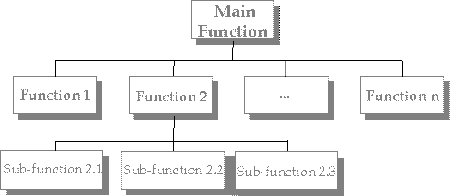Common menu bar links
Breadcrumb Trail
Institutional links
Chief Information Officer Branch
IT Project Review and Oversight
Enhanced Management Framework
ARCHIVED - A Guide to Effective Business Continuity in Support of the Year 2000 Challenge
 This page has been archived.
This page has been archived.
Archived Content
Information identified as archived on the Web is for reference, research or recordkeeping purposes. It has not been altered or updated after the date of archiving. Web pages that are archived on the Web are not subject to the Government of Canada Web Standards. As per the Communications Policy of the Government of Canada, you can request alternate formats on the "Contact Us" page.
Appendix C - Functional Decomposition Approach
1. How to Decompose an Organization's Main Function into a Business Model
To support the business continuity process, departments must develop a business model that accurately and uniquely identifies all the functions performed by the organization. These functions should be depicted in a tree-like fashion to reflect the hierarchical relationship between these functions (indented models can also be used).
2. Develop a Business Model
2.1 Process
The objective of this process is to conduct a functional decomposition of the department's main function into sub-functions to the point where single ownership can be assigned (see additional guidelines & tips for more direction).
2.2 Deliverable
The deliverable to be developed as part of this task is a business model or functional decomposition which accurately identifies all the functions performed by the organization and depicts them in a tree-like fashion to reflect the hierarchical relationship between these functions. A sample is provided below.
Figure C-1 – Sample Functional Decomposition
3. Techniques and Tools
This table provides a summary of the techniques and tools used for this activity. Details of the techniques and tools can be found in the referenced documents.
| Activity | Techniques and Tools |
|---|---|
| Perform Functional Decomposition |
No specific tool required. This technique can be found in many system development and business modeling methodologies. |
4. Guidelines and Tips
The following are guidelines and tips that can facilitate the performance of this activity.
- Functions consist of "actions" or "activities" that are part of a process used to deliver a service or a product (e.g. collect data, analyze data, and produce report);
- Functions are usually described with a verb and a complement (e.g. pay employee, deliver benefit, etc.);
- The functional decomposition process will refine the main functions of the department into sub-functions. To do so, it often uses the organizational structure to guide the decomposition of the main function into its lowest practical level of decomposition (i.e. look at the organizational chart to do your decomposition);
- For many departments, the lowest practical level of functional decomposition will consist of these functions were single accountability can be assigned, and where all sub-functions (children) to a parent function use the same assets (i.e. when you determine that the next level of decomposition defines functions that all use the same assets, you stop at that level). Another indicator for the lowest practical level is when the criticality (impact of a given function on the operations of the government or the department) of all the sub-functions is all equal to the parent function;
- Use existing business models within the department;
- Stay focused on the Year 2000 mission, the need is not for a perfect business model but for a list of functions that can be associated to assets and can be assigned to one individual/organization;
- Coverage (i.e. all functions) is more important than details (depth of decomposition); and
- Involve the governance structure quickly to approve the functional decomposition.

